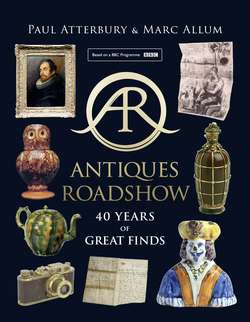Читать книгу Antiques Roadshow: 40 Years of Great Finds - Paul Atterbury, Paul Atterbury - Страница 9
OZZY THE OWL
Оглавление‘An ordinary slipware mug would have been an exciting find but the figures, like Ozzy, are rarer still, so he really was a very important discovery.’
Henry Sandon
In September 1989, Northampton’s Derngate Centre was the setting for one of the Roadshow’s most famous finds – a Staffordshire slipware owl with a detachable head, known ever since as Ozzy the Owl, even though this was the name of the mascot used by Sheffield Wednesday Football Club. The lady owner brought the owl to the Roadshow on the bus, and was very taken aback by the excitement it had generated. She could not remember how it had come into the family, only that it had been there for years, first owned by her aunt and then by her mother, and had often been used, without the head, as a flower vase.
AN IMPORTANT AND DISTINCTIVE DISCOVERY
Slipware is one of the earliest and most distinctive types of British domestic pottery, widely in use throughout the seventeenth century. The technique of decorating ordinary red, brown or buff clays with slip, or liquid clay, in other colours is even older, dating at least from the medieval period. Various decorative techniques, including pouring or dotting the slip onto the surface, scratching designs through the poured slip – a process known as sgraffito – and feathering it into swirly patterns with a quill, were all carried out before the pot was fired. When fully decorated, the pot was given a clear, lead glaze.
Slipware was associated with many parts of Britain, including the West Country, Kent, South Wales, the Midlands and Yorkshire, but the main centre of production was Staffordshire. Dishes, bowls, mugs and other domestic wares were made in large quantities by many Staffordshire potters throughout the seventeenth century and into the early years of the eighteenth, often with a distinctive and complex style of slip decoration that makes them readily identifiable. The most famous pieces are large chargers, intricately decorated in raised slip with mottoes and texts, portraits, cross-hatching and other patterns, usually in a complex but appealingly primitive style. Feathering was a favoured Staffordshire technique, creating an intricately patterned surface that looked like marbling. Some Staffordshire slipware potters are known – for example, Thomas Toft – but the majority remain anonymous, including the maker of the owls with their detachable heads. A small number are recorded, mostly in museums, and expert Henry Sandon believes that they all came from the hands of one potter.
During the filming, Henry was barely able to contain his excitement.Clutching the owl to his chest, he said that he had never handled one before. In fact, he seemed quite reluctant to give it back to the owner! He explained how the head could be used as a drinking cup, a type of vessel known in various forms since the Egyptian era. ‘Surviving pieces of Staffordshire slipware are rare and desirable, but this little drinking pot – the body would have been used as a jug and the head as a cup – is in feathered slipware, which is even rarer.’ The lady owner, increasingly bemused both by Henry’s enthusiasm and what he was telling her, was visibly shocked as he steadily increased the value from £500 to £20,000. ‘Well. I never’, was her only response. After the filming, the lady and her owl were sent home in a taxi, accompanied by two policemen, much to the consternation of her mother when she opened the front door.
BACK TO ITS ROOTS
During the eighteenth and early nineteenth centuries, there was little interest in Staffordshire slipware and it was generally dismissed as peasant pottery. It was not properly appreciated until the 1880s, when the first book about it appeared. Entitled The Art of the Old English Potter, it was written by the great French artist and designer L. M. Solon, who worked with Staffordshire ceramics company Mintons from the early 1870s. Since then, high-quality Staffordshire slipware has always been seen as rare and desirable although, unfortunately, fakes have been made since the late Victorian period. However, there was no doubt about Ozzy’s authenticity.
Not long after Ozzy’s Roadshow appearance, the family decided to part with him. He was put up for sale at Phillips auction house in London and sold for £22,000 to an agent acting on behalf of the Potteries Museum in Stoke-on-Trent. So the owl returned home and now lives in a special case in the museum, not far from where he was made in the late seventeenth century. Immediately popular, the owl has become a kind of mascot for the museum, and his presence there has greatly increased the number of visitors. On a couple of occasions since then, Henry Sandon has been reunited with Ozzy and, together, the two revisited Henry’s greatest Roadshow moment and the show’s most famous find. Later, the former owner told Henry that she had used some of the money to help support five orphans in various parts of the world.
